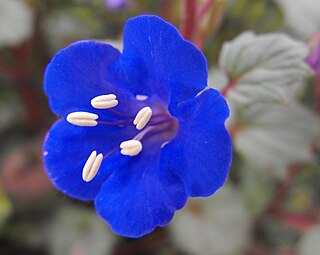
Phacelia campanularia is a species of flowering plant in the borage family, Boraginaceae, known by the common names desertbells, desert bluebells, California-bluebell, desert scorpionweed, and desert Canterbury bells. Its true native range is within the borders of California, in the Mojave and Sonoran Deserts, but it is commonly cultivated as an ornamental plant and it can be found growing elsewhere as an introduced species.
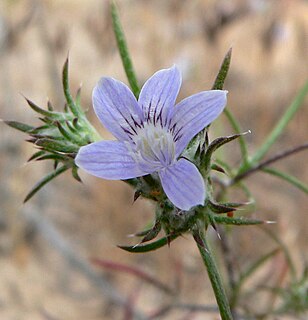
Eriastrum is a genus of flowering plants in the phlox family which are known commonly as woollystars. These wildflowers are somewhat diverse in appearance but are usually erect, thin-stemmed herbs which bear purple to white blooms. Most species have inflorescences which are webbed with a woolly mesh of white fibers. Woollystars are native to western North America.
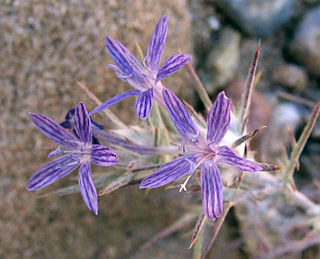
Eriastrum densifolium is a species of flowering plant in the phlox family known by the common name giant woollystar. This wildflower is native to California and Baja California where it grows in open areas such as sand dunes and dry washes. It grows on an erect stem with slightly hairy to densely woolly foliage, often giving the plant a dark gray-green color. The leaves are narrow and spike-shaped with pointed lobes. The top of each stem is occupied by a bunched inflorescence full of woolly leaflike bracts and funnel-shaped, flat-faced flowers. The flowers are each 1 to 3 centimeters long with a face up to three or four centimeters wide. The lobes are white to bright, striking blue, sometimes with longitudinal pinstripes. The stamens protrude from the throat.
Eriastrum luteum is a species of flowering plant in the phlox family known by the common names yellow woollystar and yellow-flowered eriastrum. This wildflower is endemic to California where it is known only from Monterey and San Luis Obispo Counties. This is a small annual rarely reaching the maximum 25 centimeters in height. It has occasional thin, threadlike leaves which are covered in a coat of woolly hairs. The inflorescence is a cluster of leaflike green or reddish bracts strung densely with cobwebby white wool and bearing bright yellow flowers. Each flower has five rounded lobes and long, protruding stamens with large anthers.

Eriastrum sapphirinum is a species of flowering plant in the phlox family known by the common name sapphire woollystar. This wildflower is endemic to California where it is found in many habitats throughout the state. It is an annual reaching anywhere from 5 to 40 centimeters in height, forming clumps or singular spindly stems. The stem is erect and may be reddish to green, and has the occasional threadlike leaf with sparse hairs to a coat of dense wool. The inflorescences at the tips of the stems are packed with pointed, leaflike green to red bracts and funnel-shaped flowers. The corolla of the flower has five lobes each one half to one centimeter long and pale to bright blue. The throat of the flower is the same color or yellowish to white. At the mouth of the tube there may be dots of yellow and white. The light colored stamens protrude.
Erythronium pluriflorum is a rare species of flowering plant in the lily family Liliaceae which is known by the common names manyflower fawn lily,golden fawn-lily, and Shuteye Peak fawn lily.
Eriastrum abramsii is a species of flowering plant in the phlox family known by the common name Abrams' woollystar. The epithet abramsii commemorates LeRoy Abrams. It is endemic to California, where it is known from the hills of the Coast Ranges in and around the San Francisco Bay Area. It is an annual herb producing a thin, usually woolly stem up to about 15 centimeters tall. The leaves are divided into several narrow, threadlike linear lobes. The inflorescence is a woolly cluster of narrow, leaflike bracts laced with webby fibers. The small flowers have yellow throats and white or blue corolla lobes.
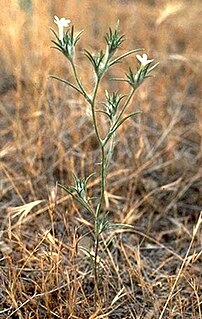
Eriastrum brandegeeae is a species of flowering plant in the phlox family known by the common name Brandegee's woollystar. It is endemic to California, where it is known from the chaparral and woodlands of the North Coast Ranges, generally on volcanic soils. There have been specimens collected from the San Francisco Bay Area which are closer to this species than other Eriastrum, but may actually be a new species. This is an annual herb producing a thin, usually woolly stem up to about 30 centimeters tall. The leaves are divided into several narrow, threadlike linear lobes. The inflorescence is a woolly cluster of narrow, leaflike bracts laced with webby fibers. The small flowers have white to light blue corollas.
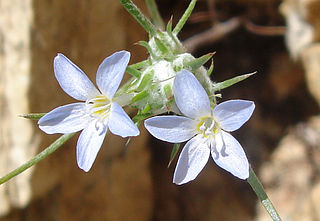
Eriastrum diffusum is a species of flowering plant in the phlox family known by the common name miniature woollystar. It is native to the southwestern United States from California to Texas, where it grows in many types of open habitat. This is an annual herb producing a thin, usually woolly stem up to about 20 centimeters long, growing erect or spreading outward. The leaves are divided into 2 to 4 narrow, threadlike linear lobes. The inflorescence is a woolly cluster of narrow, leaflike bracts laced with webby fibers. The small flowers are funnel-shaped, with yellowish throats and white to pale blue corollas.
Eriastrum virgatum is a species of flowering plant in the phlox family known by the common name wand woollystar. It is endemic to California, where it is known the coastline and coastal mountain ranges of Monterey and San Benito Counties. It grows in chaparral and coastal and inland scrub habitat. It is an annual herb producing a thin, usually woolly stem up to about 40 centimeters tall. The leaves are narrow and thick, up to 5 centimeters long, and sometimes divided into two narrow lobes. The inflorescence is a woolly cluster of narrow, leaflike bracts laced with webby fibers. The flowers have yellow throats and bright blue corollas with lobes up to a centimeter long.
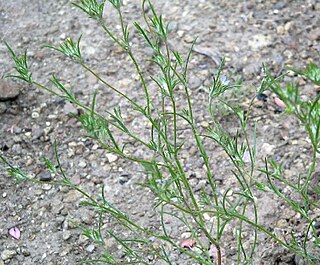
Eriastrum wilcoxii is a species of flowering plant in the phlox family known by the common name Wilcox's woollystar. It is native to the western United States, where it grows in various types of desert and plateau habitat. It is an annual herb producing a thin, branching, usually woolly stem up to about 30 centimeters tall. The leaves are narrow and thready, up to 3 centimeters long, and sometimes divided into two or more lobes. The inflorescence is a woolly cluster of narrow, leaflike bracts laced with webby fibers. The small flowers have yellow throats and blue corollas with lobes up to half a centimeter long.
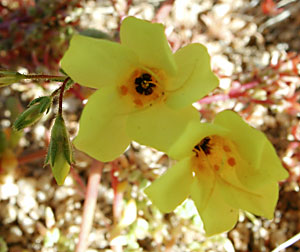
Leptosiphon aureus is a species of flowering plant in the phlox family known by the common name golden linanthus.

Leptosiphon nuttallii is a species of flowering plant in the phlox family known by the common name Nuttall's linanthus.
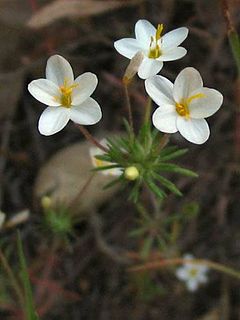
Leptosiphon parviflorus is a species of flowering plant in the phlox family known by the common name variable linanthus.
Monardella linoides is a species of flowering plant in the mint family known by the common name flaxleaf monardella.
Navarretia setiloba is a rare species of flowering plant in the phlox family known by the common names Paiute Mountain pincushionplant and Piute Mountains navarretia.

Oenothera californica, known by the common name California evening primrose, is a species of flowering plant in the evening primrose family.

Oenothera primiveris is a species of flowering plant in the evening primrose family known by the common names yellow desert evening primrose, bottle evening-primrose, and desert evening-primrose.

Phacelia nashiana is a species of phacelia known by the common name Charlotte's phacelia. It is endemic to California, where it is known only from the ecotone where the lower Sierra Nevada and Tehachapi Mountains transition into the Mojave Desert. It grows in scrub and woodland and on granite mountain slopes.

Saltugilia is a genus of flowering plants in the phlox family, Polemoniaceae. They are known commonly as woodland gilias. There are four species. Two are endemic to California in the United States, and the distributions of the other two extend into Baja California in Mexico.














